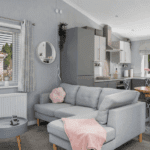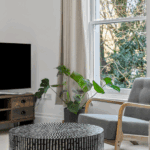Layer it up: why texture is the secret ingredient to great interior design
Ever walked into a room that just felt right — but couldn’t quite put your finger on why?
Chances are, it wasn’t just the colour on the walls or the furniture layout. It was the texture. The subtle contrast between soft and structured. The layers of finishes, fabrics, and materials that give a space soul.
Texture and layering in interior design are often what take a room from feeling flat to feeling finished — from staged to lived-in.
What do we mean by texture and layering?
Texture in interior design comes in two forms: visual texture (what you see) and tactile texture (what you feel). Think smooth marble, velvet cushions, warm timber, rough linen, shiny brass — each adds its own character.
Layering is how we combine these elements to build a sense of depth, contrast and comfort. It’s what makes a room feel like you’ve thought about everything, without it feeling overdone.
Why texture matters
Without texture, a room can feel cold or one-dimensional — even if the layout is great. Layering in texture:
- Adds depth and warmth
- Helps define mood (cosy, calm, bold, relaxed)
- Creates subtle contrast and visual interest
- Makes neutrals sing
It’s a quiet design power move — and often one of the first things I notice when a space feels not quite right.
A real-life example: St Leonards extension
In this contemporary extension project, I created a rich, layered interior that felt inviting and with a wow factor without shouting for attention. I combined:
- A faux wood floor for warmth and texture underfoot
- Concrete details to ground the space and add edge
- Marble surfaces and velvet sofas for softness and elegance
- Brushed gold accents for a hit of polish and light
The result? A space that felt contemporary but comfortable, cohesive but full of subtle contrast. Expertly showing how texture and layering in interior design can make all the difference in creating a perfect space.
How to add texture and layering in your own home
You don’t need to start from scratch. Try:
- Mixing smooth and rough finishes (e.g. linen + leather, glass + wool)
- Adding soft accessories like throws and cushions in varied weaves
- Layering window treatments (voile + shutters)
- Introducing natural materials — rattan, jute, wood
- Using rugs and floor textures to zone areas
Start small, build slowly — and trust your eye. If it feels a bit flat, it probably needs a touch more contrast.
Want your home to feel more “you”?
I help clients create homes that don’t just look great in photos — but feel calm, layered, and totally lived in. If you’re planning a renovation, extension or just feel stuck with your space, book a free 30-minute discovery call and let’s chat about how layering, styling and smart texture choices can bring your space to life.
This blog is part of my “Back to Basics with Interior Design” series, where I’ll share tips to help you create spaces that are functional, stylish, and personal. See previous posts and stay tuned for the next post: Furniture Placement: Avoiding Common Mistakes


